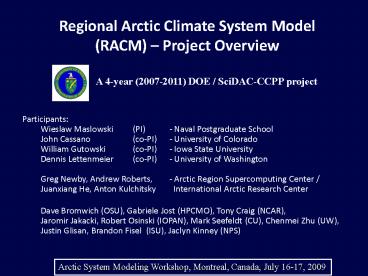Regional Arctic Climate System Model (RACM) - PowerPoint PPT Presentation
1 / 17
Title: Regional Arctic Climate System Model (RACM)
1
Regional Arctic Climate System Model (RACM)
Project Overview
A 4-year (2007-2011) DOE / SciDAC-CCPP project
- Participants
- Wieslaw Maslowski (PI) - Naval Postgraduate
School - John Cassano (co-PI) - University of
Colorado - William Gutowski (co-PI) - Iowa State
University - Dennis Lettenmeier (co-PI) - University of
Washington - Greg Newby, Andrew Roberts, - Arctic Region
Supercomputing Center / - Juanxiang He, Anton Kulchitsky International
Arctic Research Center - Dave Bromwich (OSU), Gabriele Jost (HPCMO), Tony
Craig (NCAR), - Jaromir Jakacki, Robert Osinski (IOPAN), Mark
Seefeldt (CU), Chenmei Zhu (UW), - Justin Glisan, Brandon Fisel (ISU), Jaclyn
Kinney (NPS)
Arctic System Modeling Workshop, Montreal,
Canada, July 16-17, 2009
2
Need for Regional Arctic Climate System Model
- There are large errors in global climate system
model simulations of the Arctic climate system - Observed rapid changes in Arctic climate system
- Sea ice decline
- Greenland ice sheet
- Temperature
- Arctic change has global consequences
- Sea ice change can alter the global energy
balance and thermohaline circulation
3
Observed Rate of Loss Faster Than GCM Predicted
- "A linear increase in heat in the Arctic Ocean
will result in a non-linear, and accelerating,
loss of sea ice. Norbert Untersteiner, Prof.
Emeritus, Univ. of Washington, July 2006
Adapted from Stroeve et al., 2007
4
NSIDC ice extent
GCM Comparison September 2002 Regions 1
Greenland Shelf 2 Eastern Arctic 3 Western
Arctic
3
2
1
- Too much ice in the western Arctic
- and over Siberian shelves through 2007
- Too little ice in the eastern Arctic through 2007
5
Selected IPPC-AR4 model September sea ice results
MIROC
CCSM3
HadGEM1
GFDL-CM2
6
Ocean Heat Transport
- 25 yr mean volume transport (Sv) / Heat Transport
Observations NAME POP/CICE CCSM
Fram Strait(Inflow) 7.0 Sv / 50 TW 6.9 Sv / 45 TW 2.0 Sv / 17 TW
FJL NZ (Net) NA / Near zero 2.6 Sv / 2.2 TW 4.35 Sv / 31 TW
NPS TRANSPORTS (Maslowski et al., JGR,
2004) Fram Strait in obs estimates - Courtesy
of A. Beszczynska-Möller, AWI FJL-NZ -
(Gammelsrod et al., JMS 2008)
7
Our rationale for developing a regional Arctic
climate System Model (ASM)
- Facilitate focused regional studies of the Arctic
- Resolve critical details of land elevation,
coastline and ocean bottom bathymetry - Improve representation of local physical
processes feedbacks (e.g. forcing deformation
of sea ice) - Minimize uncertainties and improve predictions of
climate change in the pan-Arctic region
8
Specific Goals
RACM Science Objective
To synthesize understanding of past and present
states and thus improve decadal to centennial
prediction of future Arctic climate and its
influence on global climate.
- develop a state-of-the-art Regional Arctic
Climate system Model (RACM) including
high-resolution atmosphere, ocean, sea ice, and
land hydrology components - perform multi-decadal numerical experiments using
high performance computers to understand
feedbacks, minimize uncertainties, and
fundamentally improve predictions of climate
change in the pan-Arctic region - provide guidance to field observations and to
GCMs on required improvements of future climate
change simulations in the Arctic
9
RACM Domains for Coupling and Topography
- Innermost POP / CICE
- gridcell 10km
- Middle WRF / VIC
- gridcell 50km
- Outermost POP/WRF
- Pan-Arctic region to include
- all sea ice covered ocean in the northern
hemisphere - Arctic river drainage
- critical inter-ocean exchange and transport
- large-scale atmospheric weather patterns (AO,
NAO, PDO)
Flux Coupler - CCSM/CPL7
10
Coupling of WRF and CPL7
- Led by Juanxiong He with contributions from Greg
Newby, Tony Craig, and Mark Seefeldt - Minimize changes to WRF and CPL7
- Add new surface routine to WRF to accept fluxes
from CPL7 - WRF/CPL7 working in global configuration
- Currently implementing regional domain with
WRF/CPL7
11
Coupling of VIC and CPL7
- Led by Dennis Lettenmaier and Chunmei Zhu with
Tony Craig - Currently have VIC coupled to CPL7 running in
data mode - Next step is to resolve issues with interactive
VIC / atmosphere simulations
12
Coupling of POP / CICE with CPL7
- Led by Wieslaw Maslowski, Jaromir Jakacki, Tony
Craig and Gabriele Jost - POP/CICE/CPL7 runs in a spinup mode with WRF in
data and VIC in slab mode - Minimal computational cost using CPL7
13
Modeled Sea Ice Thickness Loss
NPS Arctic Model Effort (NAME) Sea ice thickness
(m) in (a) 1982, (b) 1992, (c) 2002 (Maslowski et
al., 2007)
14
Modeled Ice Extent, Thickness, and Volume
- Between 1997-2004
- annual mean sea ice
- concentration has
- decreased by 17
- mean ice thickness has
- decreased by 0.9 m
- or 36
- ice volume decreased by
- 40, which is gt2x the
- rate of ice area decrease
15
Ocean Heat Transport
- Modeling challenge Inflow of Pacific/Atlantic
water and impacts on sea ice - Pacific water enters via narrow Bering Strait
- Outflow via Fram Strait vs inflow fromAtlantic
bottom water - Heat loss from Pacificand Atlantic water
priorto entering Arctic
Mean Oceanic Heat Convergence (0-120 m)
16
Sea Ice Shearin CICE-9kmIce thickness
distribution and deformationsare critical to
air-sea interactions and challenging to represent
in GCMs
17
RACM 2009-2010 Outlook
- Finalize component model / CPL7 coupling
- Fully coupled simulations
- Evaluation of fully coupled model
- Multi-decadal simulations
- Retrospective
- Future climate
- Long-term goals
- Regional simulations for IPCC reports
- Additional climate system components
- Ice sheets
- Biogeochemistry































